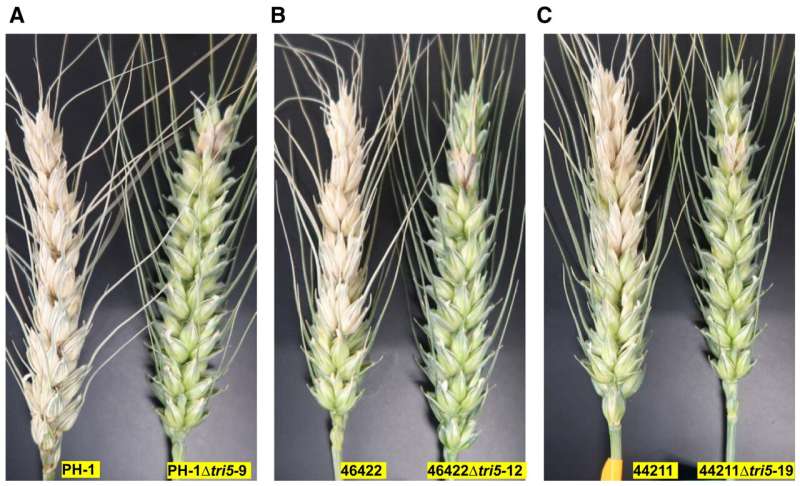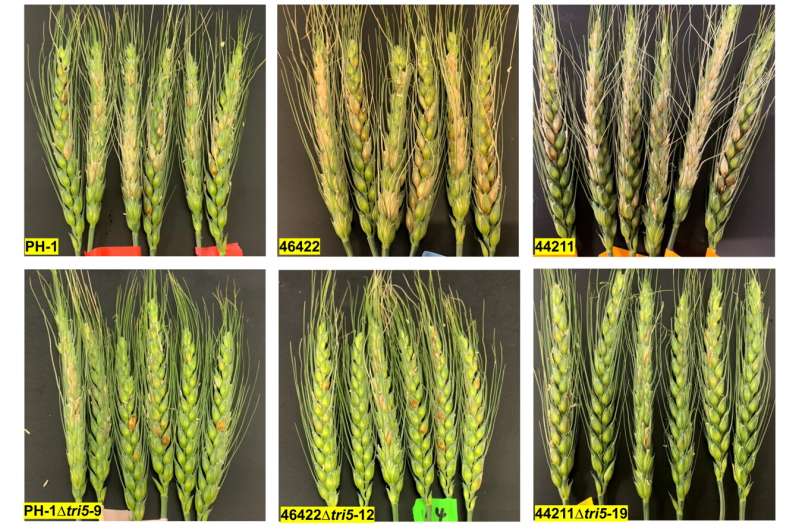This article has been reviewed according to Science X's editorial process and policies. Editors have highlighted the following attributes while ensuring the content's credibility:
fact-checked
peer-reviewed publication
proofread
New toxin facilitates disease infection and spread in wheat

Although wheat was among the first domesticated food crops, it remains a global dietary staple several millennia later. Grown on every continent except Antarctica, wheat is the second highest produced grain worldwide, with nearly 800,000 metric tons grown each year (Food and Agriculture Organization).
However, a fungal pathogen named Fusarium graminearum causes the devastating disease Fusarium head blight (FHB) on wheat and contaminates grains with harmful toxins called trichothecenes. One such trichothecene, called deoxynivalenol (DON), is produced by most F. graminearum strains in the United States, and it is an essential virulence factor that increases the pathogen's spread within a wheat head. This tiny yet powerful fungus threatens the economic security of millions of people and the food security/safety of billions more.
Currently, there are no known wheat (or barley) varieties that can completely resist Fusarium infection, prompting continual studies on FHB virulence factors. Recent studies have identified an F. graminearum population that produces a new trichothecene, called NX, with a slightly different chemical structure than DON. Dr. Guixia Hao and colleagues from the USDA-Agricultural Research Service investigated whether these NX trichothecenes contribute to FHB of wheat like DON.
The results of their study, published in the journal Molecular Plant-Microbe Interactions (MPMI), reveal that NX trichothecenes play an important role in F. graminearum initial infection as well as FHB spread.

By deleting the first gene for trichothecene biosynthesis production, TRI5, from strains representing DON trichothecenes and NX trichothecenes, the researchers were able to assess FHB severity on susceptible wheat heads inoculated with these parent strains and the genetic mutants resulting from the deletion.
Evaluation and further testing showed a higher amount of toxin produced by the NX-producing strain than the DON-producing strain. This reveals that deletion of one gene eliminates NX toxin production and decreases both fungal infection and disease spread in wheat, confirming that NX plays a similar role as DON in pathogen aggression and uniquely intensifies pathogen infection.
Commenting on the novelty of this finding, Dr. Hao says, "To the best of our knowledge, this is the first time that a mycotoxin (any toxic substance produced by a fungus) has been found to play a role in enhancing both pathogen infection and disease spread in wheat head."
This novel finding is especially exciting since it can be used to protect the quantity and quality of cereal grain crops. "The information we discovered provides a new way to potentially control infection (not merely reduce symptoms), FHB spread, and mycotoxin poisoning simultaneously by targeting the fungus's ability to produce NX," Dr. Hao explains, "And this study ultimately improves our understanding of how the fungus uses toxins as a new weapon to attack the plant."
This knowledge can also inspire further studies on NX trichothecenes. Dr. Hao and colleagues are working on a follow-up study to generate transgenic plants that target the NX biosynthesis gene by ribonucleic acid interference (RNAi) to reduce disease and mycotoxin production.
More information: Guixia Hao et al, NX Trichothecenes Are Required for Fusarium graminearum Infection of Wheat, Molecular Plant-Microbe Interactions (2023). DOI: 10.1094/MPMI-08-22-0164-R
Journal information: Molecular Plant-Microbe Interactions
Provided by American Phytopathological Society



















